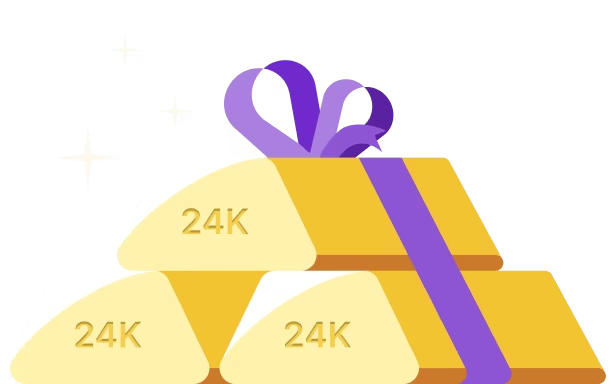Gold has always held a special place in Indian hearts and portfolios. While physical gold remains popular, Gold Exchange Traded Funds (ETFs) offer a modern, hassle-free way to invest in the precious metal.
Let's explore the top 5 gold ETFs in India as of May 2025, focusing on their performance, costs, risks, and tax implications.
1. Nippon India ETF Gold BeES (GOLDBEES)
- AUM: ₹20,783.15 crore
- Expense Ratio: 0.8%
- 1-Year Return: 30.82%
- 5-Year Return: 13.95% CAGR
- Tracking Error: 0.80%
- NAV: ₹79.88 (as of May 28, 2025)
- Risk Level: High
Overview: Gold BeES is one of India's oldest and most liquid gold ETFs. It closely mirrors gold prices, making it a reliable choice for investors seeking exposure to gold without the hassles of physical storage.
Pros:
- High liquidity
- Strong long-term performance
Cons:
- Slightly higher expense ratio compared to peers
- Moderate tracking error
2. HDFC Gold ETF
- AUM: ₹9,562.90 crore
- Expense Ratio: 0.59%
- 1-Year Return: 31.47%
- 5-Year Return: 14.11% CAGR
- Tracking Error: 0.53%
- NAV: ₹82.34 (as of May 28, 2025)
- Risk Level: High
Overview: Managed by HDFC Mutual Fund, this ETF offers a balanced approach with competitive returns and a reasonable expense ratio.
Pros:
- Strong recent performance
- Lower expense ratio
Cons:
- Slightly higher tracking error
Check out the best gold mutual funds in India.
3. SBI Gold ETF
- AUM: ₹7,719.86 crore
- Expense Ratio: 0.73%
- 1-Year Return: 30.77%
- 5-Year Return: 13.44% CAGR
- Tracking Error: 0.53%
- NAV: ₹81.78 (as of May 28, 2025)
- Risk Level: High
Overview: Backed by SBI Mutual Fund, this ETF provides a trustworthy option for investors seeking to diversify their portfolios with gold.
Pros:
- Strong brand trust
- Consistent performance
Cons:
- Higher expense ratio
- Moderate tracking error
4. ICICI Prudential Gold ETF
- AUM: ₹7,294.75 crore
- Expense Ratio: 0.50%
- 1-Year Return: 31.14%
- 5-Year Return: Data not specified
- Tracking Error: 0.53%
- NAV: ₹82.62 (as of May 28, 2025)
- Risk Level: High
Overview: With the lowest expense ratio among the top ETFs, ICICI's offering is cost-effective, making it appealing for long-term investors.
Pros:
- Lowest expense ratio
- Strong recent returns
Cons:
- Limited long-term performance data
- Moderate tracking error
5. Kotak Gold ETF
- AUM: ₹7,416.14 crore
- Expense Ratio: 0.55%
- 1-Year Return: 30.02%
- 5-Year Return: 14.02% CAGR
- Tracking Error: 0.28%
- NAV: ₹79.93 (as of May 28, 2025)
- Risk Level: High
Overview: Kotak's ETF stands out with the lowest tracking error, indicating precise replication of gold prices.
Pros:
- Lowest tracking error
- Competitive expense ratio
Cons:
- Slightly lower 1-year return compared to peers
Find out the best gold stocks in India based on their performance.
Key Metric Comparison
|
ETF Name |
AUM (₹) |
Expense Ratio |
1-Yr Return |
5-Yr CAGR |
|
Nippon India ETF Gold BeES |
20,783.15 Cr |
0.73% |
30.82% |
13.95% |
|
HDFC Gold ETF |
9,562.90 |
0.59% |
31.47% |
14.11% |
|
SBI Gold ETF |
7,719.86 |
0.73% |
31.47% |
13.44% |
|
ICICI Prudential Gold ETF |
7,294.75% |
0.50% |
31.14% |
N/A |
|
Kotak Gold ETF |
7,416.14 |
0.55% |
30.02% |
14.02% |
What are gold ETFs?
Gold Exchange Traded Funds (ETFs) are investment funds that track the price of physical gold.
Instead of buying and storing physical gold bars or coins, investors can buy units of a gold ETF on the stock exchange, similar to how stocks are traded.
Each unit represents a certain quantity of gold held by the fund, allowing investors to gain exposure to gold price movements without the hassle of safekeeping or security concerns.
Gold ETFs combine the benefits of physical gold with the convenience and liquidity of stock market trading, making it an efficient way to include gold in your investment portfolio.
Why Invest in Gold ETFs?
- Easy and Convenient: No need to worry about storage, security, or purity issues associated with physical gold.
- Liquidity: Gold ETFs can be bought and sold on the stock exchange during trading hours, offering high flexibility.
- Cost-Effective: Typically have lower expense ratios and transaction costs compared to buying physical gold or sovereign gold bonds.
- Transparency: NAV (Net Asset Value) and market prices are regularly updated, helping investors make informed decisions.
- Diversification: Gold often behaves differently from stocks and bonds, helping reduce overall portfolio risk.
- Tax Benefits: Gold ETFs have specific tax advantages compared to physical gold, such as favorable long-term capital gains treatment.
Risks to Consider
- Market Volatility: Gold prices can fluctuate due to global economic factors.
- Tracking Error: Differences between ETF returns and actual gold prices.
- Liquidity: Some ETFs may have lower trading volumes, affecting buy/sell ease.
- Currency Fluctuations: Since gold is priced in USD, INR/USD exchange rates can impact returns.
Tax Implications
- Short-Term Capital Gains (STCG): If held for less than 3 years, gains are taxed as per your income slab.
- Long-Term Capital Gains (LTCG): Held for more than 3 years, gains are taxed at 20% with indexation benefits.
- No STT: Securities Transaction Tax is not applicable on gold ETFs.
Conclusion
Gold ETFs offer a convenient and efficient way to invest in gold without the challenges of physical storage.
But the starting cost of investing in gold ETFs can often be very high. If you are looking to invest in gold without the hassle of physical storage and maintenance, you can save in Jar Gold. Jar App allows you to save your money as digital gold and start from as low as Rs.10.









